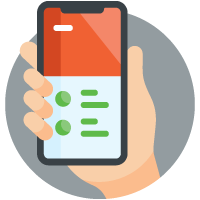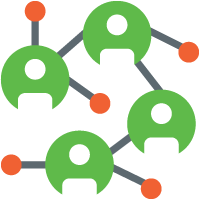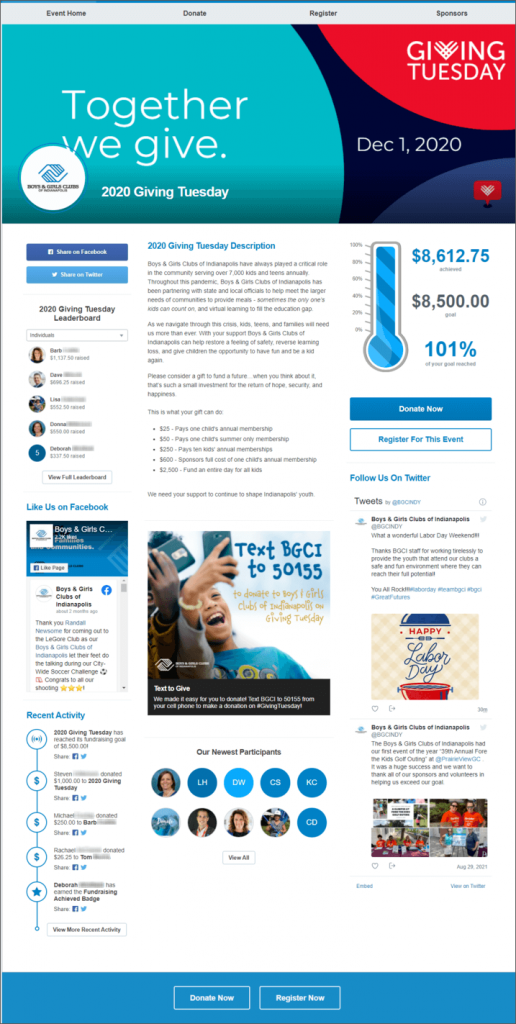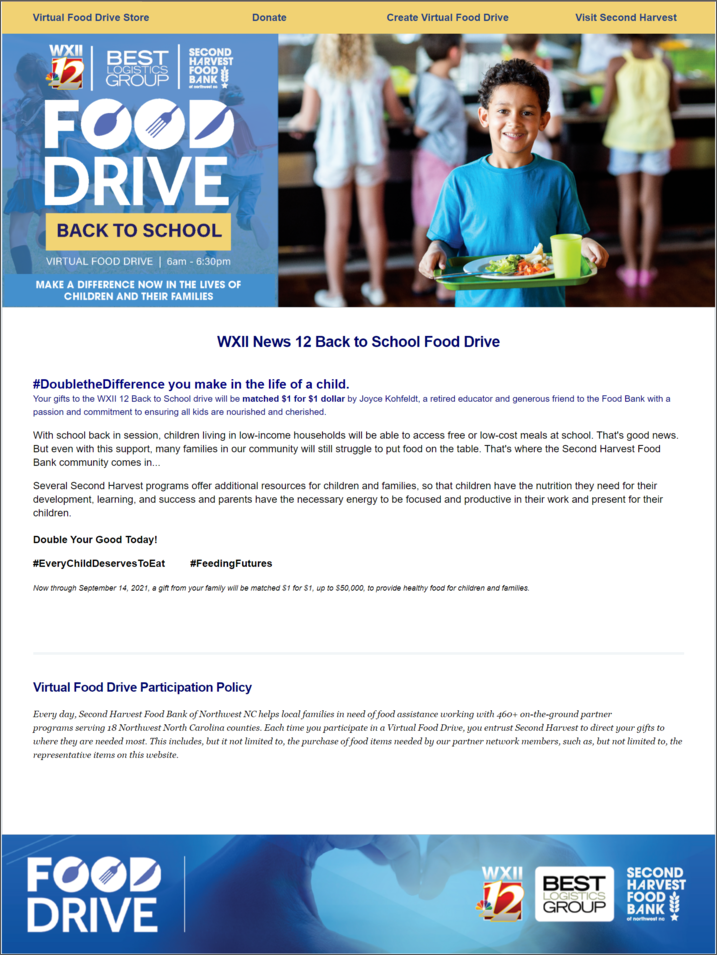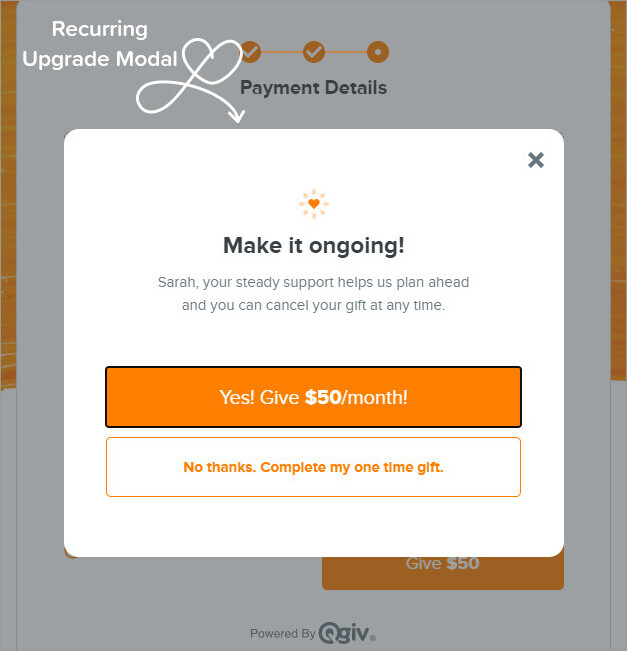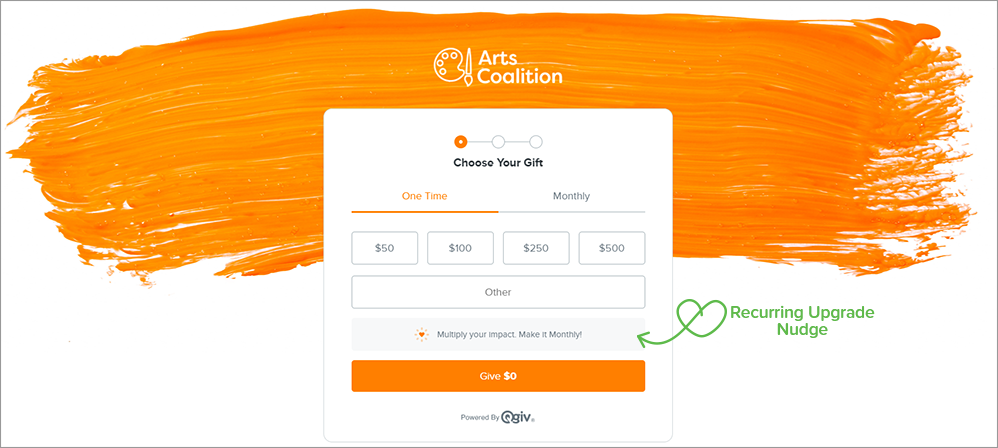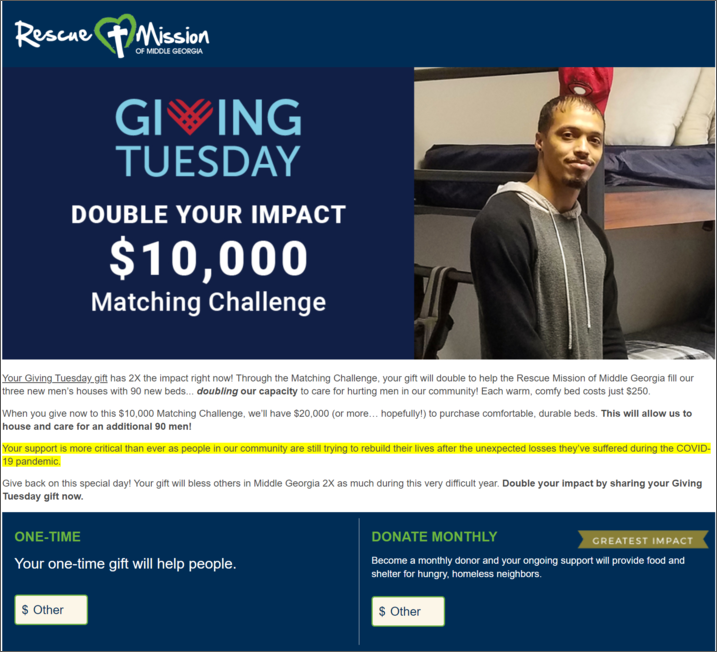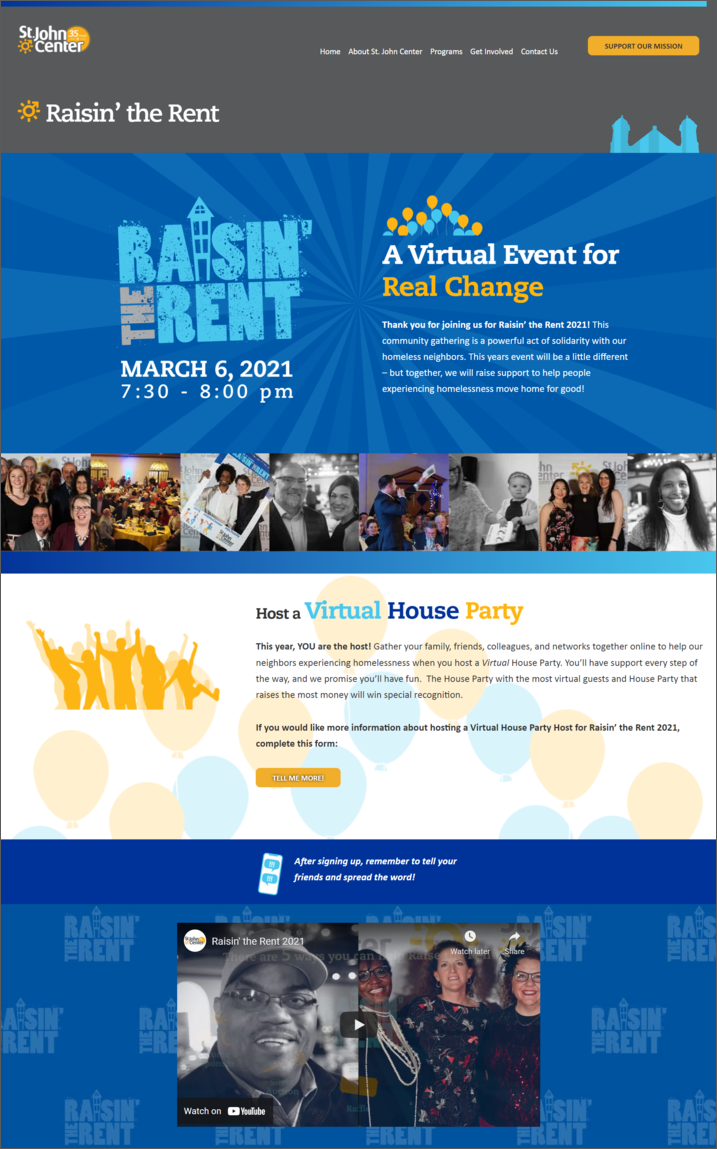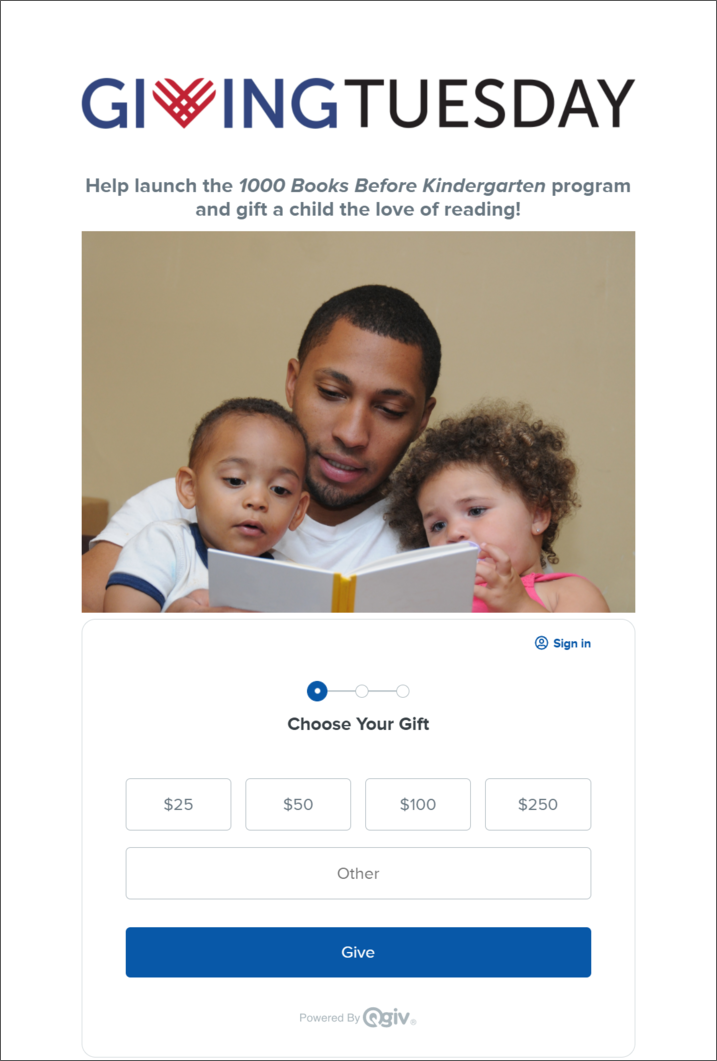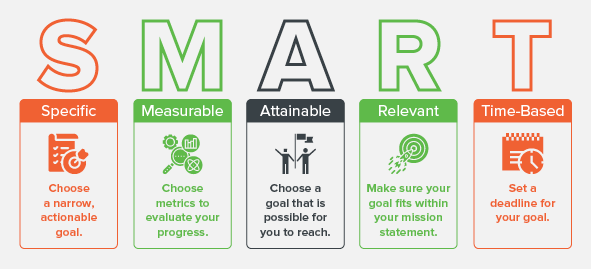There’s a reason the holiday season is called the most wonderful time of the year!
Despite increasing commercialism, the holidays traditionally get people thinking about ways they can give—whether they’re wrapping gifts for loved ones or donating time and money to a cause they care about.
For your nonprofit, this means the holiday season opens the door to opportunities for fundraising success—and there’s no better way to kick off this successful year-end fundraising push than to participate in Giving Tuesday!
Giving Tuesday is a day of global generosity and charitable giving that takes place on the first Tuesday after Thanksgiving in the United States. It’s a great day for tapping into holiday generosity and increasing exposure for your organization, which is why you need to start preparing now.
When is Giving Tuesday 2023?
Giving Tuesday 2023 is on November 28th, the Tuesday after Thanksgiving. Many nonprofits begin planning for Giving Tuesday in the summer, but even if you’re new to Giving Tuesday and only have a few weeks to prepare, you can still set yourself up for success.
Explore this definitive guide to learn more about Giving Tuesday, get great campaign ideas, and soak up some best practices.
- Giving Tuesday FAQs
- 15+ Surefire Giving Tuesday Campaign Ideas to Set You Up for Success
- Giving Tuesday Campaign Best Practices
Ready to learn more about Giving Tuesday and how your nonprofit can make the most of it? Let’s get started!
See how Qgiv can help you bring your Giving Tuesday campaign ideas to life! Request Demo
Giving Tuesday FAQs
Giving Tuesday is the Tuesday after Thanksgiving in the United States. According to Giving Tuesday’s website, it is “a global generosity movement unleashing the power of radical generosity.”
Taking part in Giving Tuesday can mean many different things—from participating in an organized service project to donating to a nonprofit to smiling at a stranger.
Giving Tuesday was created in 2012 at the 92nd Street Y’s Belfer Center for Innovation and Social Impact in New York City. Since then Giving Tuesday has grown into a global movement, inspiring millions of people to get involved in doing good in their communities.
Giving Tuesday has come a long way since its inception in 2012. As awareness about this movement has grown, so has its success. More and more money is donated on this national day of giving each year. In fact, despite the challenges presented by the COVID-19 pandemic in 2020, Giving Tuesday reported that 35 million American participants gave $2.47 billion to causes they care about, a 29% increase from 2019. Giving Tuesday 2021 raised even more for nonprofits, with donors giving 102.52% of the amount given in 2020.
Giving Tuesday 2020 also ushered in a new focus on online fundraising that has continued to this day. From 2020’s total donation amount, nearly one-third came from online donations, for a total of $808 million.
Any nonprofit or NGO can participate in Giving Tuesday, and there’s no payment or registration needed. You can, however, join your local Giving Tuesday movement to localize your efforts. And don’t forget to use the hashtag #GivingTuesday to publicize your campaign and let supporters know about your involvement.
Now that you know what Giving Tuesday is about, it’s time to prepare your Giving Tuesday campaign ideas. Read on to learn more!
15+ Surefire Giving Tuesday Campaign Ideas to Set You Up for Success
Because so many organizations participate in Giving Tuesday, it can be easy to get lost in the mix if you’re not prepared. Luckily, with a great Giving Tuesday campaign idea, you don’t have to jeopardize your chances for success. Here are 15+ of our favorite campaign ideas for your consideration:
1. Use a text fundraising campaign.
People are busy around the holidays. So why not encourage them to give while they’re on the go?
You can easily set up a text fundraising campaign for Giving Tuesday by following these steps:
- Select an easy-to-remember keyword for your text campaign. Your supporters will need to opt-in to your text fundraising campaign by sending a specific keyword to your organization. Don’t choose something long and complex that people are bound to forget. Keep it simple. For example, instead of something like “WestwoodHumaneSocietyGivingTuesdayCampaign2021,” try “WHS21.”
- Build your campaign contact lists. For a text fundraising campaign to be successful, you need to get a bunch of supporters involved. Make sure you’re tailoring your messages to different groups of people by creating segmented contact lists, like a list of new supporters and a separate list of longtime supporters. And don’t forget to let your supporters opt in
- Plan messages for before, during, and after your campaign. You need different messages for different stages of your campaign. Send save-the-date reminders and early access to your donation form beforehand, and, on Giving Tuesday itself, send your main donation appeal. Your messaging will also be important after the fact, as you’ll need to thank your donors and encourage them to continue supporting your mission.
Once you have your keywords, contact lists, and messages planned, a text fundraising campaign can be a hassle-free way to pull in donations on Giving Tuesday. Plus, your supporters can make a difference from wherever they may be.
One last pro tip: Make sure you have a reliable text fundraising tool to make your text campaign successful!
2. Make your Giving Tuesday campaign a peer-to-peer experience.
Giving Tuesday is a great time to encourage your donors, staff, volunteers, and board members to reach out to their own networks of friends, family, and professional connections. Try a peer-to-peer experience to boost the impact of your campaign and acquire more donors that you can then steward after Giving Tuesday.
Here’s what we recommend for your Giving Tuesday peer-to-peer campaign:
- Gamify the campaign. Use a fundraising thermometer and raffle for the supporters who pull in the most fundraising dollars to motivate your donors. A little competition can go a long way in helping you secure donations.
- Encourage social sharing. Social media is a great tool for supporters to share their personal fundraising pages, so make sure you encourage them to post their pages. Boost engagement by writing encouraging comments on these posts while the campaign is running or giving social media shoutouts to supporters who are pulling in lots of donations.
- Choose the right platform that will set you up to get the most out of your campaign. You can create everything you need for your campaign with Qgiv’s peer-to-peer fundraising platform, which empowers you to create your own branded fundraising pages, communicate with participants via email, and integrate with Facebook fundraisers. Our platform also provides personal fundraising dashboards for participants and tools for gamifying the campaign. Check out this video to learn more:
The Boys and Girls Club of Indianapolis reached 101% of their fundraising goal on Giving Tuesday 2020 by using Qgiv’s platform. Check out their event page for inspiration:
3. Team up with local news.
Many local news organizations like to host an annual food or gift drive around the holidays. Try partnering with your local news station to increase the reach of your campaign. They can help solicit monetary donations for your organization, or in-kind donations to your supply drive, depending on your needs.
Plus, you’ll get free publicity for your campaign and tap into a whole new group of supporters—the news station’s audience.
The Second Harvest Food Bank of Northwest NC partnered with WXII News 12 for a successful back-to-school food drive. Get an idea of what your campaign could be like by checking out their event page:
4. Host an auction.
Auctions are fun at any time of year, but Giving Tuesday presents extra opportunities for your nonprofit to host a successful auction. Whether your auction is live or silent, participants will enjoy the opportunity to bid on and win items, especially because people are typically working to get gifts for loved ones and book travel around this time of year.
Here are some ideas for auction items you could get people bidding for:
- Holiday presents or goodie baskets
- Holiday hams or turkeys
- Catered holiday meals
- Bed and breakfast or hotel stays
- Ski resort passes
- Tropical vacation packages
- Plane tickets
- Holiday home decor like wreaths or garlands
- Pre-decorated or themed Christmas trees
- Outdoor recreation items like kayaks, snowboards, or beach umbrellas
- Tickets to holiday theatre, choir, or dance performances
Whatever you choose to auction off, make sure you use a platform like Qgiv to streamline your auction experience with fast registration, check-in, and easy bidding. A reliable auction platform also makes it easy to extend this experience to the virtual space!
Pro tip: Get as many of your sponsors involved as possible, whether that means donating items or providing a venue for the day of. Business owners will love having the opportunity to make a difference on Giving Tuesday.
5. Try a modernized telethon.
A traditional telethon is a fundraising event broadcast on television during which donors can call in and give to a cause. A telethon typically consists of entertainment and commentary about the cause, as they can sometimes go for hours or even days.
You can put a twist on a typical telethon by hosting your own on a platform like Facebook Live or Twitch. Ask local performers to appear on your livestream or send in a video performance recorded ahead of time. You can even interview beneficiaries, volunteers, staff, or board members to give your telethon viewers a look into the impact your organization is having on your community.
Make sure you actively encourage viewers to make donations. You might even offer a small branded item, like a t-shirt or calendar for the coming year, to motivate your supporters to give.
Plus, a telethon is also a great event for a matching gift drive. When a donor hears something like, “Donate within the next 20 minutes and your donation will be matched by one of our board members,” they’ll be excited to increase their impact.
6. Start a recurring giving campaign.
Giving Tuesday may sound like a great one-off event for your organization, but you may also be worried about retaining donors in the long run. You can solve this problem by choosing a more sustainable Giving Tuesday campaign idea—a recurring giving campaign.
Though a recurring giving campaign may not bring in major gifts upfront, it will give you a system for pulling in a steady income stream for the months following Giving Tuesday and beyond. According to our fundraising statistics, monthly donors give 42% more in one year than one-time donors.
Here are some tips for setting up your own recurring giving program:
- Encourage donors to opt in to recurring giving on your donation form. You’re more likely to get people participating in recurring giving if you make it easy for them. If you’re using Qgiv, use tools like a recurring nudge or recurring modal that encourages donors to make their gift a recurring donation.
- Communicate often with your recurring donors. Even though recurring donors won’t have to consciously think about giving a monthly gift because they’re billed automatically, they still want to feel valued by your organization. Make sure you’re making an effort to reach out to them on a regular basis. Send texts and emails or have your staff members call and get to know your donors for an extra personal touch.
- Keep up to date with lost, canceled, and expired credit cards. Credit card changes are one of the biggest challenges for nonprofits running a recurring gift program. Encourage your donors to update their card information often, and don’t hesitate to reach out when you see a payment not go through.
Once you have the basics of your recurring giving program nailed down, you can kick it off and publicize it on Giving Tuesday. Try pitching recurring giving as a way for supporters to increase their impact and give on a more regular basis than just once a year on Giving Tuesday. You can even pair the kick-off of your program with another campaign, like a text fundraising campaign or a peer-to-peer campaign.
7. Plan a social media campaign.
Since Giving Tuesday is a global movement that is becoming more and more well known, social media campaigns are a great option for encouraging your supporters and prospects to donate, participate in an act of service, or attend an event on the day of. Here are some ways you can set up a successful Giving Tuesday social media campaign:
- Tailor your messaging to different platforms. Each social media platform has a different focus. For example, LinkedIn is a professional network where people generally discuss issues related to the workplace and share professional updates. X, on the other hand, is a more casual social media platform where people share life updates of 280 characters or less. This means posting the same thing on each platform you choose for your campaign isn’t the best idea. You need to plan ahead to make sure your message matches the needs of the chosen platform, and by default, your audience on that platform.
- Schedule your posts. Instead of trying to remember what needs to be posted and where and when, schedule your posts in advance. This will help you stay organized, reduce your team’s stress, and get great content to your supporters.
- Use the hashtag #GivingTuesday. When you use a hashtag on social media, you’re grouping your content with the other content contained under that hashtag. This makes your cause visible to people browsing for causes to support on Giving Tuesday. Plus, it helps to show that you’re participating in this global movement of generosity!
- Leverage your organization’s branding in your social media posts. Even though having your posts grouped under #GivingTuesday is helpful for people looking to give to organizations like yours, it’s still a good idea to think through how you can make your posts distinctive. Use your brand’s logos, color schemes, and fonts to make posts that stand out from the crowd.
One bonus benefit of choosing a social media campaign for Giving Tuesday is that you’ll not only pull in donations—you’ll also pull in more followers, who can turn into donors and volunteers in the future.
8. Encourage donors to increase their impact with a matching gifts drive.
When you build a Giving Tuesday campaign around matching gifts, you’re doing two things: getting donors excited about increasing their individual impact and raising more money than your organization could on its own.
To start your matching gifts drive, you’ll need to find an individual or another organization, like a local business, who is willing to match your donors’ gifts up to a certain amount on Giving Tuesday.
To find this partner, ask your board members for recommendations or reach out to some of your regular sponsors. Local businesses especially love getting public recognition for gift matching, as it helps reinforce their position in the community as a company that cares about their community.
Rescue Mission of Middle Georgia is an example of an organization that set up a matching gifts drive for Giving Tuesday. Here’s what their donation page looked like:
Notice how the language on the donation page encourages donors to take advantage of the opportunity to increase their impact! This is something you can emulate on your own matching gifts drive page.
9. Throw Giving Tuesday house parties.
House parties are fun events in which your supporters, staff, and board members host their family and friends in their homes and encourage them to give to your cause throughout the event. These can work as in-person, virtual, or even hybrid events. Here’s how to set one up:
- Have your supporters sign up to host one of the parties (and be sure to provide them with a livestream link if your house parties will be virtual or hybrid).
- Encourage your supporters to plan fun activities, entertainment, and food for their parties. You can even provide the supplies to make each house party branded and more connected to your organization.
- Provide materials and messaging templates for your supporters to send out invitations, whether through email, social media, or direct mail.
- On the day of, check in with your hosts to ensure things are going smoothly. Attend the house party (or parties) and spread the word about your organization’s mission!
St. John Center for Homeless Men hosted a virtual Raisin’ the Rent house party event in March 2021. Here’s what their event page looked like:
10. Set up an online store with Giving Tuesday-exclusive swag.
It’s fun for supporters to get a little something in return for contributing to their favorite organization. One of our favorite ideas for a Giving Tuesday campaign is to set up an online store. There are a number of items you can sell in an online store:
- Exclusive Giving Tuesday swag
- Hats
- T-shirts
- Mugs
- Bracelets
- Posters
- Bumper stickers
Publicize your online store by posting about it on social media. Also, don’t forget to incorporate it into your online donation page! This is a Giving Tuesday campaign idea that will continue to bring in more donations long after Giving Tuesday ends. Plus, every time someone wears your merch, they’re promoting your cause!
11. Invite your supporters to a fundraising gala.
If you have the time to plan a large-scale event for Giving Tuesday, a gala might be just the thing for you. Galas are sophisticated parties during which your supporters dress up, eat great food, enjoy entertainment, and maybe bid on auction items.
Here’s how to set one up:
- Send out a save-the-date email. As we mentioned before, it can be difficult for your supporters to find time for a big Giving Tuesday event if it isn’t on their holiday season calendar. Make sure to send out a save-the-date email far in advance to secure a spot on their calendars!
- Book a venue, entertainment, and catering. To pull off a fancier event like a gala, you’ll need a place that looks the part and food and entertainment that get people excited about attending. Try reaching out to local performers and catering companies. This is also a great time to acquire sponsors and seek auction items.
- Plan out donation appeals you can make throughout the event. A Giving Tuesday gala is fun for your guests, but your main focus should be acquiring donations throughout the night. Plan out specific appeals you can make in between songs or activities to get your guests giving throughout the night. You should also make it easy for them, too. Try offering text fundraising options or print out cards with a QR code guests can use to access your donation form.
- Thank your guests for attending. Your gala shouldn’t be a one-hit-wonder. Make sure you send out gracious thank-you notes to everyone in attendance. This will help you hang on to your supporters far into the future and get them involved in upcoming fundraisers and events.
One other thing you can do to make your gala special is to give it a theme. Try throwing a holiday or season-themed gala to celebrate both the holiday season and your cause!
12. Hold a one-day “Stock the Pantry” drive.
Depending on the nature of your organization, it might be beneficial to hold a “Stock the Pantry” drive for in-kind gifts on Giving Tuesday instead of monetary donations. “Stock the Pantry” drives are fun for supporters to participate in throughout the year, but especially when they’re coming off of a weekend of holiday shopping with Black Friday and Cyber Monday and can pick up items for your organization along the way.
Whether you’re collecting school supplies, clothing, or canned food, Giving Tuesday gives you the chance to get an influx of donated items. Have supporters drop by your facility to deliver items or collect them in drop boxes around your community. Be sure to thank your donors and encourage them to get involved with your organization in other ways.
The Friends of the Davenport Public Library had a successful Giving Tuesday “Stock the Pantry” drive in which they collected donations to launch their 1000 Books Before Kindergarten program:
13. Host a concert.
Everyone loves a good concert, and people are especially craving live entertainment after a year and a half of canceled or postponed events. Try reaching out to local singers, bands, choirs, or orchestras to donate a performance. You can even host the concert online and livestream it for your supporters to enjoy from the comfort of their homes. Here are some ways to spice it up even more:
- Ask supporters to send in song requests
- Offer a way for donors to pledge a certain amount of money to “dedicate” a song to a loved one
- Sell branded merchandise or refreshments during the concert
- Make your concert holiday-themed!
- Offer a meet and greet with the performers for donors who give a certain amount
Remember to schedule your concert well in advance so your supporters can plan it into their holiday season calendars!
14. Plan a trivia night.
Trivia nights are perfect for your supporters who have a competitive side. Set up your trivia night at your facility or a local bar/restaurant and charge a small entrance fee or team registration fee. Here are some ways to keep your supporters engaged during the event:
- Offer a prize or a registration fee donation match for the team that gets the most questions right.
- Encourage participants to donate to your cause throughout the event.
- Sell drinks, snacks, and other refreshments to increase your profit.
- Include extra elements in your trivia game, like the opportunity to phone a friend or steal a question from another team.
Pro tip: Include some questions about Giving Tuesday—just don’t make them too hard!
15. Launch a major campaign.
Perhaps your organization needs a new building, expensive equipment, or simply has a gap in the budget after the challenges presented by COVID-19.
Take the opportunity to get a major campaign rolling on Giving Tuesday. You could, for example, have a goal of reaching 50% of your fundraising goal on the first day of your campaign (Giving Tuesday!). Motivate your supporters by tying your fundraising goal to something tangible. Try shooting for something like, “If we reach our goal today, we’ll be able to sign the contract and break ground.”
This is another Giving Tuesday idea that will pay off in the future; it’s a great way to kick off a major campaign that you can work on for the next few months or years. For more information on planning for your major campaign, check out this capital campaign guide from Qgiv.
See how Qgiv can help you bring your Giving Tuesday campaign ideas to life! Request Demo
Giving Tuesday Campaign Best Practices
Once you’ve selected one of the Giving Tuesday campaigns above, it’s time to put your campaign into action. Here are some best practices to help you stay organized and on schedule for Giving Tuesday 2023!
Giving Tuesday Campaign Best Practices: Planning
For a really successful Giving Tuesday campaign, you’ll need to prepare in the weeks and months leading up to the big day. Laying the groundwork beforehand will help you maximize your fundraising potential.
1. Set a clear goal.
Clearly define your fundraising goal for your year-end giving campaign and then define how Giving Tuesday will contribute to that goal.
We recommend you set a SMART goal—a goal that is:
- Specific
- Measurable
- Attainable
- Relevant
- Time-based
For example, do you want to raise 10% of your year-end fundraising goal? 20%? 50%? How long does your campaign need to be to achieve this goal? How is it relevant to your larger mission? Thinking through the SMART goal elements will guide your organization and motivate your team to achieve the goal you set.
While you’re setting goals, it’s also important to take donor data from past campaigns and events into account. Have you run a Giving Tuesday campaign before? If so, how many of your donors gave? Who are they? Knowing how well your fundraising campaigns have performed in the past and who your donors are can help you set SMART goals for Giving Tuesday.
Additionally, it’s important to articulate your goal in your marketing plan so you can communicate your goal to your donors through social media posts and on your donation page. (Pro tip: Try a visual representation of your progress, like a fundraising thermometer!) This enables donors to see the impact of their contributions and may provide extra motivation for them to give more (or even give again!) to help you achieve your goal.
2. Test your donation form in advance.
The last thing you want to deal with on Giving Tuesday is problems with your donation form. Make sure you test it in advance and troubleshoot any issues.
If you make significant changes to your donation form, we recommend you try A/B testing your form. Here’s how to do it:
- Build two forms for the same campaign.
- Make sure there are just a few differences between the forms so you can accurately identify if any particular calls to action, images, or stories are making a difference.
- Have half of your team use the first form and the other half of your team use the second form.
- Go over your results and choose which donation form will work best for your campaign.
If you want to see some potential improvements in action, take Qgiv’s interactive donation form templates for a spin!
3. Delegate tasks ahead of time.
You can avoid encountering incomplete tasks on Giving Tuesday by delegating tasks to certain staff members ahead of time.
Assign different members of your team to be in charge of social media posts, livestreaming videos, or monitoring campaign progress. Your Giving Tuesday campaign is bound to be a success when everyone is clear about what they’re supposed to be doing!
Pro tip: Always include a link to your online donation page when posting on social media.
4. Connect with community leaders.
Part of laying the groundwork for a successful Giving Tuesday will include connecting with your community. For example, you might try setting up a booth at a local farmer’s market to spread awareness about your cause. You could also work on securing corporate sponsorships and drop off flyers or brochures to local businesses that currently sponsor your organization.
You should also work to connect with leaders of other local nonprofits or community organizations. Try to inspire the leaders of these groups to support your organization and get involved with your campaign. And don’t forget to be willing to help them out in return.
5. Focus on new donor acquisition and retention.
Your Giving Tuesday campaign should mark the launch of your year-end campaign. It gives you the opportunity to focus on new donor acquisition, which can benefit your organization in the long run.
Craft your Giving Tuesday donation appeals around gaining new donors, send customized Giving Tuesday thank-you emails to new donors, and encourage donors to share their donation on social media while encouraging others to contribute to your cause.
Make sure to make your new donors feel extra special and relate their donation’s impact so you can reach out to them again for your year-end appeal!
6. Make donor retention your top priority.
Donor retention should be your top priority, especially going into the year-end giving season and the new year.
Retaining donors is less costly than acquiring new ones, so be sure to make your donors feel extra special for supporting your cause.
For example, try automating Giving Tuesday receipts that highlight the difference your donors are making for your cause. Then follow up a few days later to thank them (more on this later!), let them know how much money they helped to raise, and what impact their donation and overall amount raised will make. After thanking your donors and reporting on their impact, you can make a second ask for a new gift within 30 days of the first.
7. Keep donors updated
Once your campaign has begun, keep the lines of communication open. Post regular updates about your fundraising progress on social media. Share stories about how the donations you’ve received so far will help support the communities you serve.
Donors will cheer when they hear they’ve helped you achieve your goal, so keep them updated throughout the day to make them feel engaged and as if they’re part of a movement, not just a day.
Giving Tuesday Campaign Best Practices: Email
1. Build a series of emails before Giving Tuesday.
Emails are a valuable asset for donor communication. But sending out just one email on Giving Tuesday won’t be enough to garner the attention you need for a successful campaign. That’s why you need to build out a series of emails before Giving Tuesday.
Introduce what Giving Tuesday is in an email sent a couple of weeks in advance. Then send out a reminder about your campaign or event the week before that includes your fundraising goal.
Next, on the day before Giving Tuesday, send out another reminder to build excitement and remind supporters about your goal and the impact they can make by donating to your campaign. On the actual day of the event, you’ll be ready to send out messages in the morning, afternoon, and evening to round out your series.
2. Experiment with different types of emails for your campaign.
Don’t be afraid to think outside the box when it comes to your Giving Tuesday email strategy. Instead of relying on run-of-the-mill emails, try out some of these different options:
- Discount emails: Offer early registration, promo codes, or gift matching information for donations or registrations completed by a certain stage of your campaign.
- Event agenda emails: This can be a follow-up to your save-the-date email and get supporters hyped for the different activities that will be part of your Giving Tuesday event.
- Appeal emails: Present a clear problem to your supporters and explain how they can help you solve it by contributing to your campaign.
- Post-event surveys: Get feedback from your supporters to improve your fundraising strategy for next year’s Giving Tuesday (or your upcoming year-end fundraising push). This will let your supporters know you care about their experience with your organization, not just getting donations.
Try experimenting with different types of emails. Get input from your team or ask a small focus group of supporters to let you know what the emails make them think and feel.

Giving Tuesday Campaign Best Practices: Marketing
The best way to guarantee that your Giving Tuesday will be a success is by having a strong marketing plan. Here are some best practices to help you get the word out about your campaign.
1. Use multi-channel marketing.
If your entire marketing campaign rests on your social media channels or if you’re only sending out email blasts, chances are you’re not reaching your entire donor base. Instead, plan on posting on social media, sending emails, text messages, and direct mail, as well as possibly running ad spots through your local media companies. This multi-channel marketing approach will ensure that all of your supporters are hearing from you in the weeks leading up to Giving Tuesday.
If you want to run a successful marketing campaign, planning is key! An effective multi-channel campaign starts with having a good plan; make sure you’ve scheduled copywriting, designing, analyzing, and email or social post scheduling tasks in advance! If you can, recruit other staff, volunteer, or board members to help. You can delegate different tasks across a group of capable teammates.
2. Write out your marketing plan.
Executing a successful marketing campaign depends on having a well-thought-out marketing plan. From the first message you send to your donors to the follow up emails you’ll send once Giving Tuesday concludes, plan out every part of your marketing strategy to keep organized as you work towards your fundraising goal.
As you begin building your plan, it’s vital to keep your fundraising goal and target audience in mind. Segment your donor base into categories based on details like average gift size, how long ago they donated, and what level of support they’ve given your organization so you can send more targeted messaging. Your donor who faithfully gives every month shouldn’t receive the same messaging as your donor who gave you a $20 gift two years ago!
3. Use great design.
While the stories you tell in your marketing campaign will tug at readers’ heartstrings, the way you present your stories will get people to read them to begin with. Eyecatching design is the best way to draw people to your fundraiser and keep their attention.
Craft all your design elements in your email campaigns, social media posts, and webpages in a way that takes your supporters on a journey and gets them invested in your organization. Choose your graphics, fonts, color schemes, and images with a discerning eye to visually communicate your organization’s values and drive donations.
4. Emphasize impact.
Your supporters want to feel like their donations are making a difference. Give your donors context for why your fundraiser is important and how their support helps the communities you serve by emphasizing their impact in your marketing campaign.
Tell stories about individuals that have benefitted from your services and remind donors that your work is only possible with their support. Post pictures of your staff and volunteers in action, visually displaying how the funds you raise are being used. Knowing that their donations have an impact is what drives donors to give, so don’t be afraid to pull back the curtain on the work your organization does.
Giving Tuesday Campaign Best Practices: Social Media
Social media is an excellent tool for communicating with your donors before your Giving Tuesday campaign and providing live updates on the day of the event. Here are some best practices to make your posts stand out.
1. Schedule your posts before Giving Tuesday.
Scheduling social media posts in advance will save you a lot of stress on Giving Tuesday and ensure your posts go out at the opportune time.
Study up on your social media analytics and determine at what parts of the day you see the most engagement with your posts and social media accounts. This can guide you in creating great posts your supporters want to interact with and share.
Once you’ve drafted your posts, create a timeline or content calendar and schedule them. That will ensure they go out on your social media channels when they’re intended to, regardless of your team’s busy schedules.
2. Create an event on social media.
By creating an event page on a social media channel like Facebook, you’re setting up a dedicated space where you can post updates leading up to Giving Tuesday to ensure your supporters will be anticipating the big day.
You can also post reminders about event registration, share your donation page, livestream from the frontlines of your event, and share fundraising goal updates as they happen.
3. Use videos to keep your donors engaged.
According to a study from Google, 57% of people who watch a nonprofit video go on to make a donation. This means you should try to share at least a few videos leading up to your Giving Tuesday campaign.
According to our guide to the best types of nonprofit videos, here are some you can try to get attention from your supporters:
- Before and After Videos: Show donors how their contributions are making an impact. For example, if you’re a nonprofit organization that helps beautify city parks, record some footage of the park before your team cleans it up and after when it looks beautiful again!
- Auction Item Teaser Videos: If you’re hosting an auction as part of your campaign, get your supporters ready to bid by teasing some of your biggest items beforehand.
- Client Testimonials: Ask your clients to speak to how your organization has made a difference in their lives and record your interview with them. Putting a human face to the issue your organization is dedicated to can get your supporters to give to your campaign.
4. Let your supporters do the talking.
If your supporters are active on social media, get them talking about your cause for Giving Tuesday! Word of mouth has been and always will be one of the most effective forms of advertising. Social media multiplies its effectiveness.
For example, try creating an event hashtag (or use the hashtag #GivingTuesday) and ask your supporters to use it, whether they’re sharing your event page or posting to explain why they’re supporting your organization for Giving Tuesday.
You can also reach out to brand ambassadors on social media. Nonprofit organizations who want to get real results on Giving Tuesday need a plan to target brand ambassadors and ask them to spread the word about your organization’s mission with friends, family, and professional connections, especially because brand ambassadors tend to have large followings.
Before Giving Tuesday, start going through your social media accounts. Ask yourself these questions:
- Who interacts with you the most?
- Who shares your contests?
- Who of your followers has a large following of their own?
Use these questions to identify a few potential ambassadors for your organization and then reach out to them. Not only will they feel special and appreciated—they’ll be more likely to interact with you and share more of your posts, which means more exposure for your cause!
Make sure you explain the impact that social sharing can have for your organization. After all, you might not be asking your supporters or brand ambassadors to donate money, but they’re still donating their time and access to their social media real estate.
Giving Tuesday Campaign Best Practices: Events
Nonprofit events always have a lot of moving parts, but the pressure is really on when Giving Tuesday rolls around. Here are some things you can do to make sure your event goes off without a hitch.
1. Create a simple event registration form.
Despite its popularity, it’s important to remember that Giving Tuesday takes place during one of the busiest times of the year. After all, it falls on the Tuesday after Thanksgiving in the United States, a popular holiday that’s followed by two worldwide shopping events, Black Friday and Cyber Monday. If you want your supporters (and potential supporters) to keep your organization top of mind during this busy time, you need to get the word out early and get them to commit to participating and giving.
Try creating an event registration form and encouraging your supporters to sign up for Giving Tuesday. Even if your campaign doesn’t involve an event at all, you’ll be able to get on your supporters’ calendars and have a higher chance of them showing up for your cause on the day of.
2. Expand your reach with virtual or hybrid events.
Since it takes place during the holiday season, you’ll be competing with other events, family get-togethers, and shopping trips for your supporters’ attention on Giving Tuesday if you decide to hold a fundraising gala or other event for Giving Tuesday. One of the best ways to increase your reach at this busy time is to move your event online and go completely virtual or give your donors options with hybrid events.
Even though you can really make any Giving Tuesday campaign idea work online or in a hybrid format, it may still help to have a few more ideas. Here are some of our favorites from Qgiv’s list of virtual fundraising ideas:
- Virtual bingo nights
- Photo contests
- Cook-offs
- Virtual scavenger hunts
- Classes, tutorials, or webinars
- Online game-a-thons
Whatever event you decide to go with, you’ll need the right technology to pull it off. Read on to learn more about livestreaming in particular!
3. Get familiar with livestreaming.
Livestreaming your Giving Tuesday event can help your donors feel like they’re actually there in the room with you and their fellow supporters, even when they aren’t.
Many livestreaming platforms have some great features, like one-on-one video chats, text chat, breakout rooms, and screen recording. But there are a lot of livestreaming platforms to choose between, including:
- OBS: a free, open-source platform you can use to create live scenes
- Zoom: a video conferencing platform that is great for webinars and other types of events
- Facebook Live: a livestreaming platform that’s easy to set up and use, especially when many of your supporters already use Facebook
- YouTube Live: a platform that enables you to get your stream up and running in minutes and offers a wide variety of scheduling options
Each of these platforms has its merits, so make sure you do your research before picking one. Also, don’t forget to practice livestreaming before the big day!
4. Employ gamification to ramp up your attendees’ enthusiasm.
When your supporters have the right type of encouragement, you can raise even more than you planned! This is where gamification tools come in.
Try adding gaming elements to your campaign to make it more compelling and engaging for donors. For example, try using a fundraising thermometer to show your campaign’s progress and encourage donors to help you reach your next milestone. When you’ve reached the halfway point, be sure to let your audience know. This will help fuel excitement and drive your supporters to meet the end goal! If you’ve chosen a peer-to-peer fundraising format for your campaign, encourage participating fundraisers to earn badges by meeting different fundraising goals and milestones. That will help keep them invested in fundraising during a very busy season.
5. Use a new and unique fundraising campaign to stand out.
Are you stuck in a rut when it comes to planning your fundraising events? Not sure what’s out there other than peer-to-peer 5Ks and bake sales? Lucky for you, there’s a whole world of creative fundraising events you can draw inspiration from.
From scavenger hunts to murder mystery parties, there are plenty of events you can add to your rotation to keep your donors engaged and improve your donor retention rates. Your supporters will feel more motivated to give when they’re participating in fresh and unique fundraising campaigns.
Giving Tuesday Campaign Best Practices: Volunteers
Your volunteer force can be a big help to your organization on Giving Tuesday. Here’s how best to employ them.
1. Motivate your volunteers.
Volunteering on Giving Tuesday can be a sacrifice for some of your volunteers. You need to recognize this and work to motivate them to get involved with your campaign. Try offering incentives such as:
- Digital incentives like badges.
- Physical incentives like branded t-shirts, mugs, etc. for reaching goals.
- Fun incentives like tickets to dunk someone in a dunk tank or a coupon code to watch a livestream of someone getting their head shaved if the fundraising goal is met, etc.
Additionally, you can keep volunteers motivated by providing regular updates on your fundraiser’s progress via email, social media, or text. This will inspire your volunteers to keep going on the day of!
2. Encourage corporate volunteerism.
Many employers look for opportunities around the holidays for their employees to get involved in serving the community, like running canned food or Christmas present drives.
Network with your volunteers to find out more about their employers and then reach out to them and see if they want to get involved with your Giving Tuesday campaign for a corporate giving or volunteer day.
Giving Tuesday Campaign Best Practices: After the Fact
After months of planning, it can be easy to want to walk away from Giving Tuesday right after your campaign ends. However, some of your most important donor retention strategies take place after the fact. Check out the following best practices.
1. Don’t let your confirmation emails go to waste.
Your organization shouldn’t make the mistake of overlooking the importance of a confirmation email, especially because a donation receipt can make or break your relationship with a donor. Here’s what you should make sure to include:
- A sincere thank you
- A statement of impact (i.e., “Because of your $25 donation, we’ll be able to care for four wounded birds.”)
- Ideas for future involvement with your organization, like social sharing, recurring giving, and volunteer opportunities
2. Illustrate your donors’ impact.
Donors don’t just want to give your organization money and not know what happens to it. Share with them how their contributions are helping to make a difference and move your cause forward.
Consider sharing impact stories! Try using images to capture the human element of the impact your donors are having. Just don’t forget to explain how your Giving Tuesday campaign differs from your regular campaigns and what this special giving day means to your organization and those you support.
3. Throw a donor thankathon.
Showing your gratitude is something you should never forget to do, especially when you want to cultivate lasting relationships with your supporters beyond Giving Tuesday. Demonstrate your appreciation for their donated money, time, and talent with a thanking marathon or thankathon. A thankathon is a series of communications that occurs during the giving season and lets donors know how much you value their support.
Handwritten letters are always a meaningful way to send thanks to your donors, but you may not have the time to write thank-you notes to every single person who donated to your campaign. Try recruiting other staff to help or get your board members in on the note-writing action at your next meeting. Phone calls are another way to send a more personal thank you to your donors, but they can also be time consuming. Emails are quick and easy to send. While they may feel impersonal, you can make a lasting impression on your donors with the right design and content.
Try providing a genuine thank-you message to your donors with video, audio, and visuals. Tell them about the impact their donation will make with pictures and storytelling elements. Add personalization tags to all of your thank-you emails to keep your donors from feeling like they’re just another face in the crowd. Make sure your branding is unique to your thankathon and aimed at making your donors feel special.
4. Highlight the wins.
The fundraising season can be taxing on everyone, from dedicated volunteers to passionate staff members. That’s why it’s so important to celebrate your organization’s wins. People love feel-good stories, especially during the holiday season, so if your fundraiser has made a special impact on the communities you serve, tell those stories. Share them across your organization and with your loyal supporters.
If you raise a record-breaking amount of money this Giving Tuesday or reach a significant milestone for your organization, spread the good news with a press release. Not only will you keep the engagement going and the donations flowing, but you might also expand your reach so far that you’ll be able to introduce yourself to fresh faces and new friends.
5. Craft a follow-up plan.
As mentioned before, you’ll likely receive a lot of donations from first-time donors on Giving Tuesday, so having a follow-up plan is essential.
Even after you’ve thanked donors for their gifts with a thankathon or a similar strategy, there’s still more to do.
Offer new donors an introduction to your nonprofit and a survey they can fill out about your Giving Tuesday campaign. Then you can develop a plan for future fundraising asks. After all, donors don’t typically give to the same nonprofit more than once simply because they aren’t asked!
Final Thoughts
Giving Tuesday presents nonprofits with a great opportunity to start the year-end giving season off right. By tapping into this global generosity movement, you can not only work on meeting your fundraising goals but also spread awareness for the cause that drives you to continue your nonprofit work.
With these Giving Tuesday campaign ideas and best practices, you’ll be equipped to make this year’s Giving Tuesday one for the record books!
If you’d like to continue learning about Giving Tuesday and how to maximize your campaign, check out these additional resources:
- Giving Tuesday Checklist: Plan for Greater Success. Use this checklist to make sure you have all of your ducks in a row before Giving Tuesday begins.
- Giving Tuesday Text Message Templates. If you’re using a text fundraising campaign, you’ll need to craft some text messages that get results. Try out these templates.
- Build the Perfect Giving Tuesday Donor Journey: Part One— The Discovery Phase. Learn more about making your Giving Tuesday efforts sustainable and retaining your donors with this article.
- Bloomerang’s 33+ Giving Tuesday Ideas: Expert Tips and Campaigns to Try. These 10 Giving Tuesday tips and 23+ campaign ideas will help your nonprofit take Giving Tuesday to the next level!
See how Qgiv can help you bring your Giving Tuesday campaign ideas to life! Request Demo








